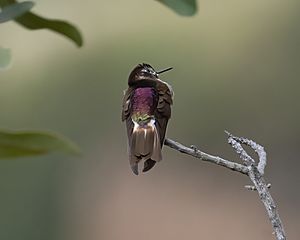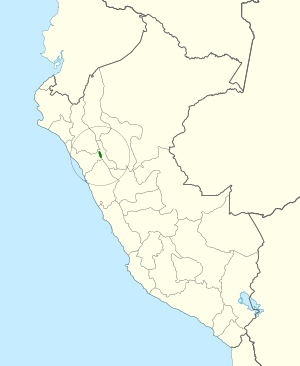Purple-backed sunbeam facts for kids
Quick facts for kids Purple-backed Sunbeam |
|
|---|---|
 |
|
| Conservation status | |
| Scientific classification | |
| Genus: |
Aglaeactis
|
| Species: |
aliciae
|
 |
|
The purple-backed sunbeam (Aglaeactis aliciae) is a beautiful bird that belongs to the Trochilidae family, also known as hummingbirds. This special bird lives only in Peru.
It makes its home in high-up areas like shrublands and plantations, where the weather is warm but not too hot. Sadly, the purple-backed sunbeam is in danger because its home is disappearing.
This hummingbird used to be listed as Critically Endangered, meaning it was at very high risk of disappearing forever. But new studies have shown there are a few more of them than we thought. Because of this, its status was changed to Endangered in 2008, and then to Vulnerable in 2020. This means it's still at risk, but not as much as before.
Contents
About the Purple-backed Sunbeam
Hummingbirds have amazing shoulders that let their wings beat super fast. They can flap their wings up to 200 times a second! This allows them to hover in the air while they eat.
Because they use so much energy, hummingbirds mostly eat nectar. Nectar is a sweet, sugary liquid from plants. They might visit 1,000 to 2,000 flowers every day!
Hummingbirds need more oxygen than almost any other animal with a backbone. They can breathe up to 500 times a minute! Their lungs are also specially shaped. These unique body features help hummingbirds live in many different places and at various heights across the Americas.
What We Know About Them
We don't have a lot of information about the purple-backed sunbeam specifically. However, we know it eats nectar from orange-red mistletoe flowers that grow on Alnus trees. It uses its special beak and long tongue to get the nectar.
Like most hummingbirds, the purple-backed sunbeam is usually alone. It is also very protective of its territory.
Reproduction and Family Life
Male purple-backed sunbeams will mate with several females. However, the males do not help raise the young birds. The female hummingbird does all the work. She builds the nest, sits on the eggs to keep them warm, and takes care of the baby birds after they hatch.
No one has ever seen a purple-backed sunbeam's nest. But scientists believe they build their nests close to where they can find nectar. They probably hide their nests on branches away from direct sunlight. Most hummingbirds lay two oval-shaped eggs. The eggs usually hatch after about 16 to 19 days. The baby birds stay in the nest for about 23 to 26 days after hatching.
Where They Live
The purple-backed sunbeam lives in mountain areas between 2,900 and 3,500 meters high. In these places, you can find mountain shrubs and Alnus trees.
They feed on mistletoe that grows on alders and other trees like Tristerix longebrachteatum. They also eat from patches of flowering uñico and Oreocallis grandiflora. Recently, they have also been seen feeding and living in new Eucalyptus tree plantations.
However, we don't yet know how well the purple-backed sunbeam can live and raise its young in eucalyptus plantations. More research is needed to understand what these birds need to survive. This will help us figure out if eucalyptus plantations are good homes for them.
Their Role in Nature
Hummingbirds play a very important role in nature. They help plants reproduce by moving pollen from one flower to another. This process is called pollination. Many plants rely on hummingbirds to spread their pollen. Some plants have even changed over time to better suit hummingbirds! For example, in Brazil, hummingbirds pollinate at least 58 different plant families. The Bromeliaceous family is one of the main ones.
When flowers are damaged, hummingbirds might not visit them as much. This can affect how well the plant can make seeds. This shows how important hummingbirds are for plants to grow and reproduce successfully.
Dangers They Face
The biggest danger to the purple-backed sunbeam is when their natural shrubland homes are turned into eucalyptus plantations. When this happens, the parasitic mistletoe they feed on is removed.
Because these birds live in such a small area, they are also easily affected by natural events. Things like diseases or long dry periods (droughts) can harm their population.
Historically, the Maranon River valley, where they live, has lost a lot of its natural habitat. People have cleared land for farming, and much of the original forest is gone or getting worse. Raising cattle, cutting down trees for wood, and collecting firewood have destroyed a lot of their forest home. There is also a future worry about oil mining in the area.
Population and Conservation
The purple-backed sunbeam has a very small population, with fewer than 1,000 birds estimated to exist. This small number means they might not have much genetic diversity, which can make them less able to adapt to changes.
The Maranon valley is a very important area for conservation. It is far away and has unique habitats. This has led to many species, including 22 bird species, that live nowhere else in the world. Because of this, Birdlife International has chosen it as an Endemic Bird Area (EBA).
The Maranon valley is also part of a larger conservation effort called the Maranon-Alto Mayo Conservation corridor. This is because it has many areas that need protection. The American Bird Conservancy has been studying where rare birds live in the Maranon valley. They want to find and protect the most important areas and habitats.
Many ideas have been suggested to protect these birds. These include creating strictly protected areas, using land in a way that helps nature, and setting up nature reserves owned by local communities. Right now, only a tiny part (0.1 percent) of the Maranon valley has legal protection. These protective measures need to be put in place very soon.
See also
 In Spanish: Aglaeactis aliciae para niños
In Spanish: Aglaeactis aliciae para niños


